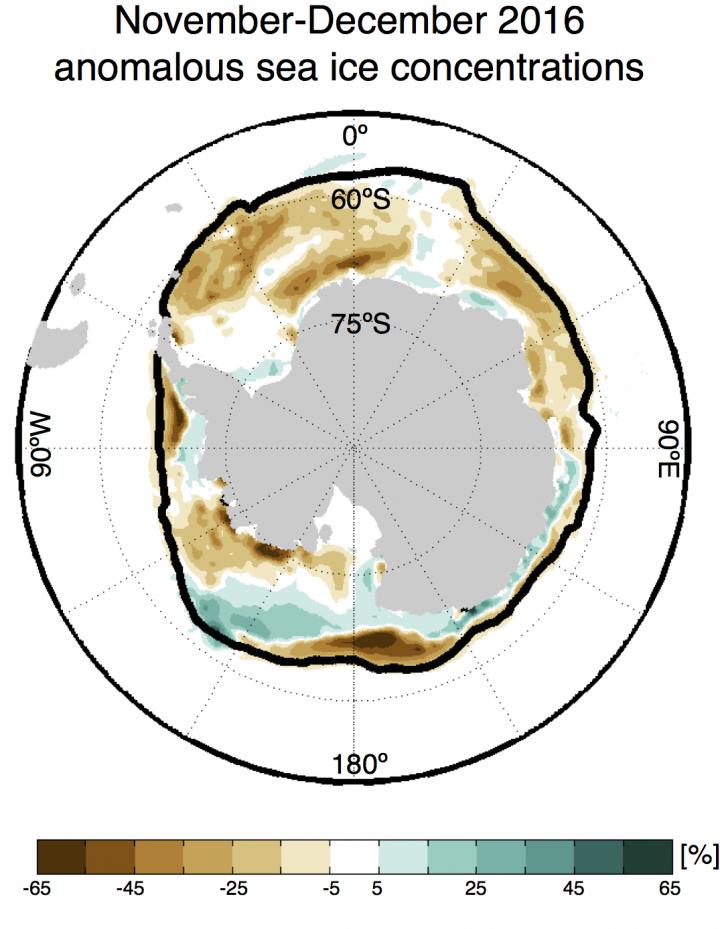
Record-low 2016 Antarctic sea ice due to 'perfect storm' of tropical, polar conditions

The percent of ocean surface covered with sea ice in 2016 was lower than usual (brown) over many parts of the Southern Ocean. The black line shows the edge of the region with at least 15 percent ice cover.
Credit: Malte Stuecker/University of Washington
A dramatic drop in Antarctic sea ice almost a year ago, during the Southern Hemisphere spring, brought its maximum area down to its lowest level in 40 years of record keeping. Ocean temperatures were also unusually warm.
This exceptional, sudden nosedive in Antarctica differs from the long-term decline in the Northern Hemisphere. A new University of Washington study shows that the lack of Antarctic sea ice in 2016 was in part due to a unique one-two punch from atmospheric conditions both in the tropical Pacific Ocean and around the South Pole.
The study was published Aug. 24 in Geophysical Research Letters.
“This combination of factors, all these things coming together in a single year, was basically the 'perfect storm,' for Antarctic sea ice,” said corresponding author Malte Stuecker, a UW postdoctoral researcher in atmospheric sciences. “While we expect a slow decline in the future from global warming, we don't expect such a rapid decline in a single year to happen very often.”
The area of sea ice around Antarctica at its peak in late 2016 was 2 million square kilometers (about 800,000 square miles) less than the average from the satellite record. Statistically, this is three standard deviations away from the average — an event that would be expected to occur randomly just once every 300 years.
The record low was not predicted by climate scientists, so UW researchers looked at the bigger picture in ocean and atmospheric data to explain why it happened.
The previous year, 2015-16, had a very strong El Niño in the tropical Pacific Ocean. Nicknamed the “Godzilla El Nino,” the event was similar to other monster El Niños in 1982-83 and 1997-98. Unlike the 1997-98 event, however, it was only followed by a relatively weak La Niña in 2016.
Far away from the tropics, the tropical El Niño pattern creates a series of high- and low-pressure zones that cause unusually warm ocean temperatures in Antarctica's eastern Ross, Amundsen and Bellingshausen seas. But in 2016, when no strong La Niña materialized, researchers found that these unusually warm surface pools lingered longer than usual and affected freeze-up of seawater the following season.
“I've spent many years working on tropical climate and El Niño, and it amazes me to see its far-reaching impacts,” Stuecker said.
Meanwhile, observations show that the winds circling Antarctica were unusually weak in 2016, meaning they did not push sea ice away from the Antarctic coast to make room for the formation of new ice. This affected ice formation around much of the Southern Ocean.
“This was a really rare combination of events, something that we have never seen before in the observations,” Stuecker said.
The researchers analyzed 13,000 years of climate model simulations to study how these unique conditions would affect the sea ice. Taken together, the El Niño pattern and Southern Ocean winds explain about two-thirds of the 2016 decline. The rest may be due to unusually big storms, which a previous paper suggested had broken up ice floes.
Scientists predict Antarctica's ocean will be one of the last places on Earth to experience global warming. Eventually the Southern Ocean's surface will begin to warm, however, and then sea ice there will begin its more long-term decline.
“Our best estimate of the Antarctic sea ice turnaround point is sometime in the next decade, but with high uncertainty because the climate signal is small compared to the large variations that can occur from one year to the next,” said co-author Cecilia Bitz, a UW professor of atmospheric sciences.
Stuecker noted that this type of big, rare weather event is useful to help understand the physics behind sea ice formation, and to learn how best to explain the observations.
“For understanding the climate system we must combine the atmosphere, ocean and ice, but we must focus on more than a specific region,” Stuecker said. “If we want to understand sea ice in Antarctica, we cannot just zoom in locally — we really have to take a global perspective.”
###
The other co-author is Kyle Armour, a UW assistant professor of atmospheric sciences and oceanography. The research was funded by the National Science Foundation and a National Oceanographic and Atmospheric Administration's Climate and Global Change Postdoctoral Fellowship Program, administered by the University Corporation for Atmospheric Research's Cooperative Programs for the Advancement of Earth System Science.
For more information, contact Stuecker at stuecker@atmos.washington.edu or Bitz at bitz@uw.edu and reach either author at 206-543-1339.














